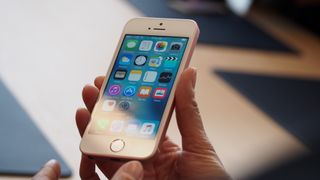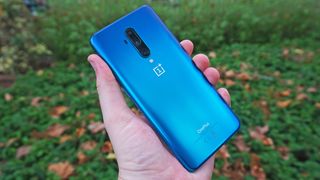Why the iPhone SE 2020 and OnePlus 8 are needed now more than foldable phones
Opinion: foldable phones are the future, but cheaper flagship phones are what we need right now

Around this time of year we’re usually eager to see the big, flashy flagship phones that were introduced at MWC finally reach the public. But this is no ordinary year, and the outbreak of Covid-19 hasn’t just caused the cancellation of MWC 2020 and other tech shows, and messed with phone releases – it’s disrupted lives all over the world.
Which makes the iPhone SE 2020 and OnePlus 8 far more important phones for consumers than premium flagships, including the foldable phones the industry has been championing as the next generation of handset technology. Even if the Samsung Galaxy Fold 2 comes out later this year as rumored, average consumers probably won't be lining up to buy it. After all, the first Galaxy Fold cost $1,980 / £1,900 / AU$2,900 at launch.
The iPhone SE 2020 and OnePlus 8 were revealed this week, and they couldn’t have come at a better time. With the slowdown in economic activity resulting in higher unemployment and interrupted cash flows for many consumers, affordability has suddenly become a lot more important - and if you can get cutting-edge features at a discount, that’s even better.
The iPhone SE 2020 and OnePlus 8 represent two approaches to solve this problem: Apple's new iPhone offers essential features at low cost, while OnePlus looks set to create a true budget flagship with 5G connectivity.

The iPhone SE 2020: Apple’s return to affordability
The iPhone SE 2020 takes after the iPhone SE as a phone that forgoes top-end features for the essentials: one rear camera, one front camera, Touch ID, the A13 chipset, and access to iOS 13 and many more updates, all in a smaller 4.7-inch display format with, yes, huge top-and-bottom bezels.
The iPhone SE 2020 fits the needs of plenty of people – it's the same price or a bit more expensive in most regions starting at $399 / £419 / AU$749 / Rs 42,500. It would certainly be a solid option for those looking for affordable functionality, and for folks who just need a device to hold them over until the economy picks up again.
While the iPhone 8 has met this need, it’s been on the market for two and a half years, and it wasn’t even much of an upgrade over the previous year’s iPhone 7.
Get daily insight, inspiration and deals in your inbox
Get the hottest deals available in your inbox plus news, reviews, opinion, analysis and more from the TechRadar team.
The OnePlus 8: affordable 5G

The OnePlus 8 isn’t much pricier than its predecessor, so it's the first true budget flagship released in 2020, since the Samsung Galaxy S20 line didn’t include a cheaper 'S20e' model.
Like the OnePlus 7T and OnePlus 7, the new phone will have top-end specs at a discount: 8GB or 12GB of RAM with 128GB or 256GB of storage, putting it solidly on par with other flagship phones.
Given the OnePlus 8 is is 5G-capable, phone it's the cheapest 5G phone in many markets, too. That means the OnePlus 8 is a bit of a bit safer investment for folks who don’t want to have to trade in the phone they buy this year just to connect to a 5G network in 2021 or later.
Sometimes, progress means staying in place
It’s not that we’re unexcited about foldables and other cutting-edge technologies; we just know they’re suddenly a lot less important than the phones that will get us all through 2020.
OnePlus’s strategy of keeping its budget flagship models low-cost happens to be suited for this moment, while Apple’s long-awaited iPhone SE 2020 couldn’t launch at a better time. Regardless, both phones are the best we could get at this moment – and until more phones launch in this mid-range/budget flagship niche, we could see these two become a lot more popular through the end of the year and beyond.
- Best cheap phones: the handset that will get you through this year
David is now a mobile reporter at Cnet. Formerly Mobile Editor, US for TechRadar, he covered phones, tablets, and wearables. He still thinks the iPhone 4 is the best-looking smartphone ever made. He's most interested in technology, gaming and culture – and where they overlap and change our lives. His current beat explores how our on-the-go existence is affected by new gadgets, carrier coverage expansions, and corporate strategy shifts.

